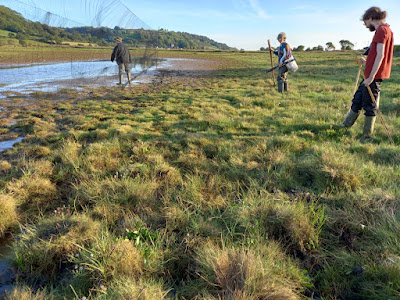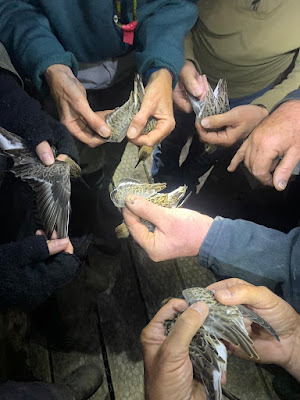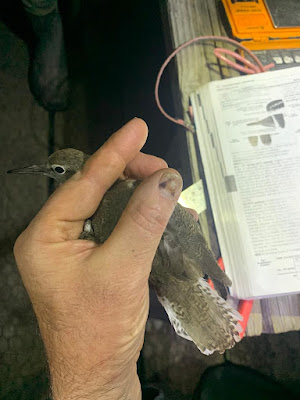It was in the pre-covid era that the last wader catch on the Axe took place, so there was much trepidation and excitement between ringers as we set up on Colyford Marsh. Teal, Curlew and Little Egret were all noted in this period, and their flight patterns influenced our placement of nets.
Wader footprints on the mud at Colyford – a promising start. (Photo: T. M. Mylett)
Mist-netting for waders requires a different approach to our monthly passerine sessions; whilst the former group is best targeted from the early morning, it tends to be more successful to catch waders as they come into roost. We set up 5 60ft nets (and herded cattle) across the tussocky terrain from 4:30-6pm, while Adrian kindly marked a clear pathway for us to use once darkness set in. Without the white bamboo canes to follow, there may have been a few too many You’ve Been Framed moments.
Setting up nets. (Photo: Robin Pearson)
Per BTO guidance for Curlew and Dunlin, and for the sake of parity, we measured tarsus and bill length of all birds caught. This proved a good opportunity to refine our skills in these areas, generally not used for the smaller birds we catch during our monthly crop field sessions. In Curlew, these measurements can prove useful to identifying the sex; females are, on average, altogether larger. In Dunlin, the same measurements can prove indicative of different subspecies.
A total of 5 Dunlin were also ringed. Because these were caught within the same net round, we were able to compare them during processing, which proved a valuable lesson in identification and ageing. Much conversation was had regarding the slight differences in plumage, and the guidance given by Jeff Baker and Laurent Demongin’s texts. The latter had a point of particularly pertinent advice preceding all discussion of the species – ageing may prove ‘very difficult’. Indeed.
Comparing Dunlin. (Photo: Mark Wills)
Other appearances were made by a Common Snipe, 5 of (presumably) the 6 cheeky Ringed Plover mentioned earlier, and 2 Common Sandpiper. The Ringed Plover were another treat, as they are the first the AERG has ever ringed.
Alan processes a Common Sandpiper, Demongin to hand. (Photo: Mark Wills)
The session proved to be the largest catch for the site, with 14 birds of 5 species caught. It was a great turn out with 10 ringers from Devon and beyond attending. All birds were newly ringed, and there were no retraps (bar 1 Dunlin, who seemingly enjoyed being processed so much the first time they hopped back into the net around 10pm).
Species | Total ringed |
Common Sandpiper | 2 |
Common Snipe | 1 |
Curlew | 1 |
Dunlin | 5 |
Ringed Plover | 5 |
14 |
Dismantling the nets in the deep jurassic dark proved a final challenge, but, as always, many hands made light work. The marsh is a mucky site to navigate and most of us had a liberal splash of Colyford mud on our gear and hands by the end of the evening. Final comments between the group included a humorous quip from Allan regarding how our own earthy covering could rival Gweneth Paltrow’s own ‘Goop’ range. We’ll leave the marketing of that idea to him…
-T. M. Mylett
Ringed | Re-trapped | |
Blackbird | 1 | |
Blackcap | 6 | |
Blue Tit | 7 | 1 |
Cetti’s Warbler | 1 | |
Chiffchaff | 5 | |
Dunnock | 3 | |
Goldfinch | 1 | |
Great Tit | 2 | |
Greenfinch | 1 | |
Reed Warbler | 1 | |
Robin | 2 | 2 |
Whitethroat | 1 | |
Wren | 1 | |
31 | 4 |









